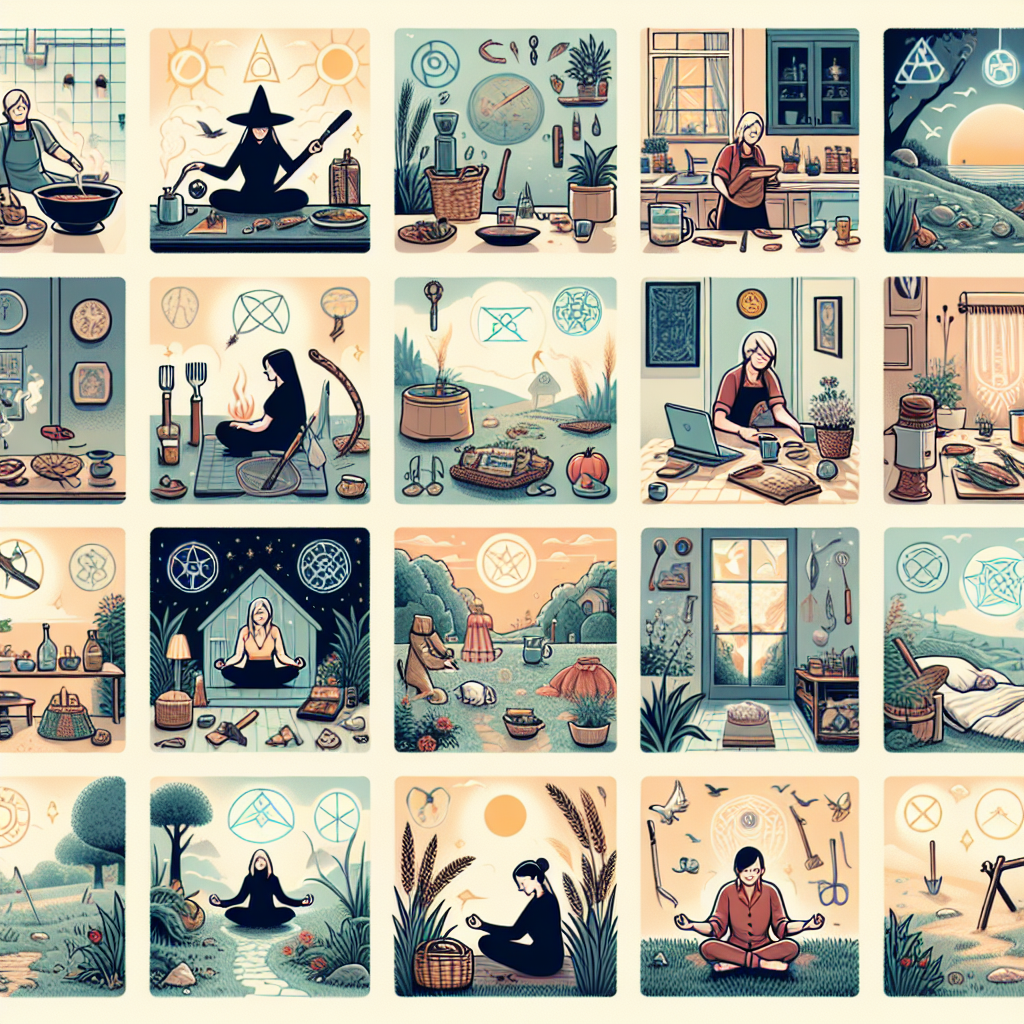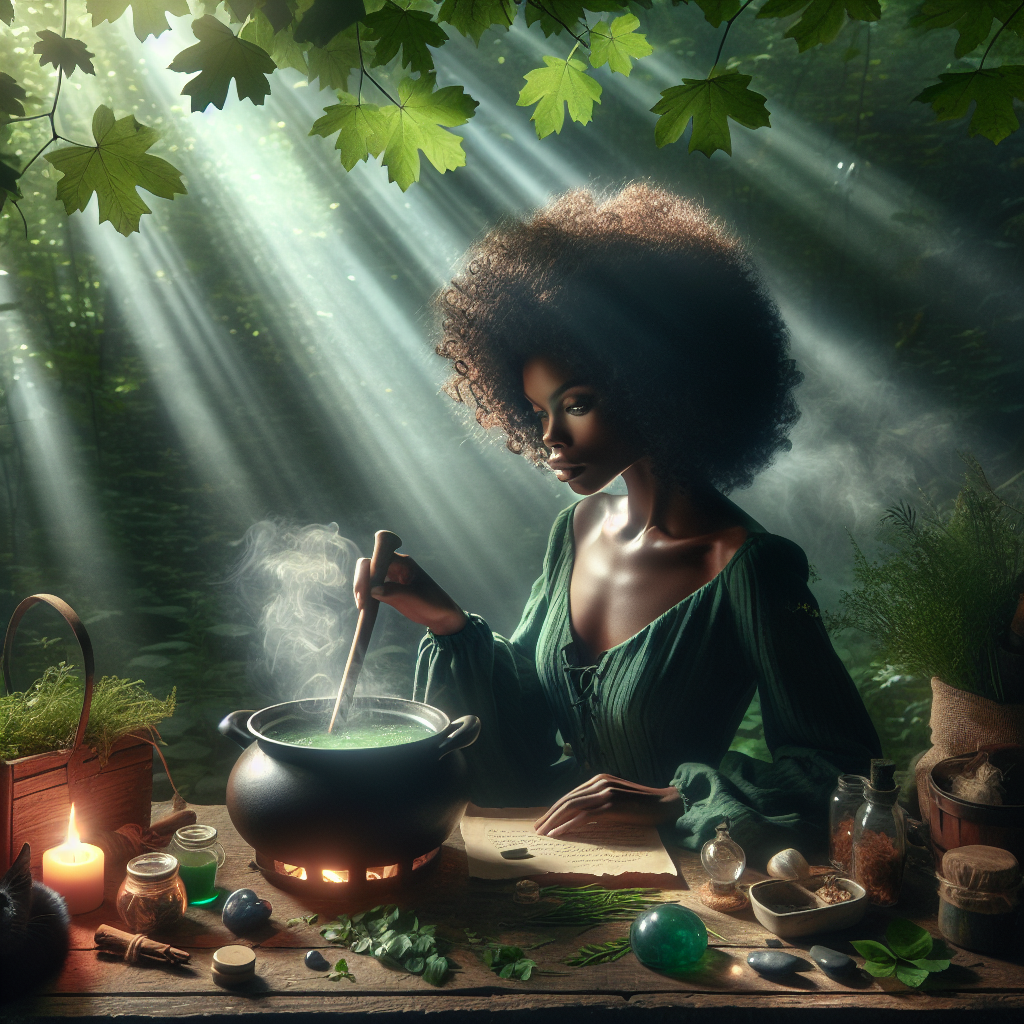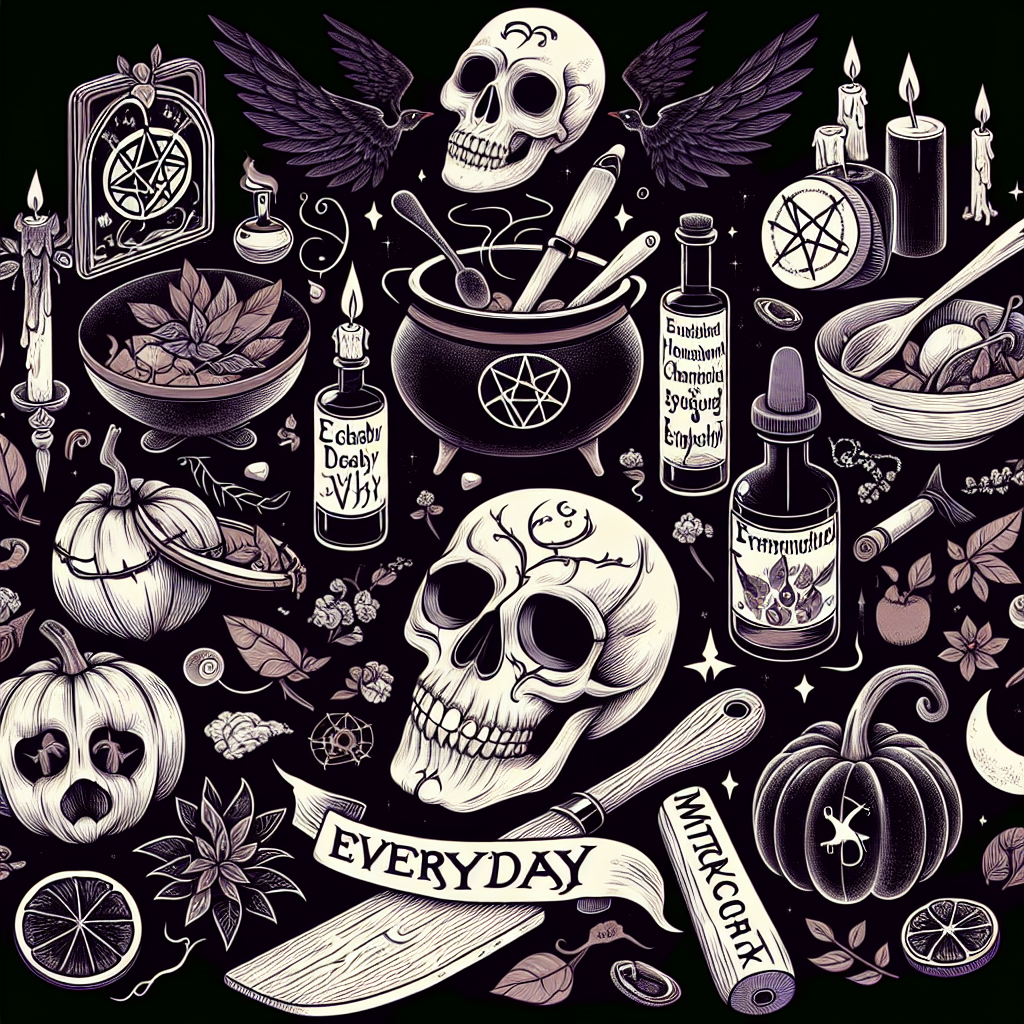As an Amazon Associate I earn from qualifying purchases.

From its ancient roots to modern practice, witchcraft has often been a means of harnessing the unseen forces of nature and the universe. Once vilified and misunderstood, it's now recognized by many as a path to personal empowerment and spiritual connection. Cultivated throughout history by diverse cultures worldwide, witchcraft has long been a tapestry of rituals, spells, and traditions aimed at influencing the physical world through supernatural means.
As witchcraft has moved from the shadows into the light of societal acceptance, individuals integrate aspects of the craft into their routines for various purposes. Whether it’s using herbs to heal, casting a circle for protection, or meditating for mindfulness, these ancient practices are finding their place in the hustle and bustle of contemporary life. Some people incorporate witchcraft into their lives as a way to honor traditions, connect with ancestors, or simply find solace in ritual.
A compelling statistic to consider is the upsurge in sales for related products and books; the last decade has seen a resurgence in interest, with an increase reported as high as 70% in some regions. Such interest spikes around Halloween, although for practitioners, the craft is a year-long commitment. Witchcraft has become a means for many to tap into natural cycles, celebrate seasonal festivals, and align their lives with the environment.
In terms of personal growth and well-being, modern witchcraft can play a unique role. Self-care rituals, often infused with witchcraft's emblematic natural remedies, support both mental and physical health. Through mindfulness practices, such as meditation within a sacred space, individuals can foster a deep sense of inner peace and clarity—a boon to everyday life that is marked by relentless tempo and stress.
Another dimension to witchcraft's contemporary application lies in the art of intention setting. By focusing on specific goals or desired outcomes, and perhaps lighting a corresponding candle or crafting a vision board, practitioners believe they can direct their energy towards manifesting their ambitions.
Culinary witchcraft is another delicious way this practice enters everyday life, with kitchen witches imbuing their cooking with specific intents, such as using basil for love or cinnamon for prosperity. The act of stirring a pot with purpose is seen as weaving magic into sustenance, nurturing both the body and the spirit.
In the domain of home and hearth, the practice of creating a protective boundary, or warding, is regarded as safeguarding one's living space. Witchcraft rituals for the home can include the use of salt, protective herbs, or crystals placed strategically to ward off negative energies. This taps into the ancient belief in the power of elements and the energetic properties of earth's resources.
Gardening, too, has magical connotations, with many practitioners of witchcraft tending to herb gardens or working with the lunar phases to sow and harvest plants. This harmony with the natural world demonstrates the witch's role as a steward of the earth and imbues everyday gardening chores with deeper spiritual significance.
Communication and connection with pets and wildlife also carry a magical undertone. Many witches believe in the importance of forming bonds with animal familiars or understanding the messages brought by encounters with wild creatures. Observing and respecting the natural instincts of animals is an exercise in intuition and empathy.
On a broader social scale, some witches engage in activism or community healing through energy work and intention. From group rituals to boost communal morale to casting spells aimed at social justice, the craft becomes a vehicle for collective empowerment and societal transformation.
Financial stability is yet another facet of life where witchcraft can be applied. Spells and rituals to attract abundance and prosperity, for instance, are common among practitioners. These often involve the use of green candles, certain herbs, and the visualization of wealth, tapping into the idea of abundance through spiritual means.
Personal relationships can benefit from witchcraft practices, too. Love spells, which are some of the most notorious yet misunderstood aspects of the craft, when used ethically, focus on fostering self-love and attracting positive connections rather than controlling the free will of others. They aim at enhancing the practitioner’s magnetism and readiness for healthy relationships.
In the creative sphere, artists and writers sometimes use witchcraft to overcome blocks and enhance their inspiration. A muse-invoking spell might involve summoning the energies of muses of old or creating an altar dedicated to the individual's personal inspiration and creative fervor.
Furthermore, dreamwork is a profound area where witchcraft intersects with everyday life. The interpretation of dreams, along with spells to induce prophetic dreams or to remember dreams more vividly, aligns with the ‘as above, so below’ principle found in many magical belief systems.
Lastly, one of the subtler ways witchcraft is woven into everyday life is through the creation of personal rituals to mark important life transitions. These can range from coming-of-age ceremonies to commemorating personal achievements, imbuing life’s milestones with profound and customized significance.
1. Protection Charms: Use witchcraft to create charms for protection to carry with you. These can help shield you from negative energy and harmful intentions.
2. Love Spells: While it’s advised to cast love spells with caution, they can be used to enhance the love and connection in your existing relationships or to open your heart to new love.
3. Healing Rituals: Craft rituals that focus on healing physical, emotional, or spiritual wounds. Use herbs, candles, and crystals that correspond with healing energies.
4. Manifesting Goals: Employ witchcraft to set clear intentions and manifest your goals. Visualization, candle magic, and creating vision boards can all be part of this process.
5. Cleansing Spaces: Regularly cleanse your home or workspace with sage, salt, or sound to eliminate stagnant or negative energy.
6. Gardening with the Moon: Use the phases of the moon to plan your gardening. Planting by the moon can help you harness the energy for growing and harvesting.
7. Cooking with Intention: Incorporate kitchen witchcraft by cooking with intention. Bless your food as you prepare it, infusing your meals with specific energies like love or health.
8. Dream Work: Before going to sleep, set an intention for your dreams. Use witchcraft to influence your subconscious and receive messages through your dreams.
9. Animal Companions: Connect with your pets or local wildlife using witchcraft. Create bonds and communicate with animals using energy and intention.
10. Empowering Jewelry: Charge your jewelry with specific purposes such as confidence, clarity, or strength, infusing your everyday wear with magic.
11. Energy Shields: Learn to visualize and construct energy shields around yourself to ward off psychic vampirism or emotional drains.
12. Moon Water: Collect rainwater or tap water during the full moon. Use the charged water for rituals, plants, or as a tonic for energy work.
13. Crystal Healing: Incorporate crystals into your daily life for their healing properties. Carry them with you, or place them in strategic locations around your living spaces.
14. Meditation and Mindfulness: Practice meditation with a magical twist, incorporating visualization techniques to deepen the practice and enhance spiritual connectivity.
15. Affirmations and Spellwork: Write and recite daily affirmations as spells to boost self-esteem and bring about positive change.
16. Herb Magic: Use the magic properties of herbs in cooking, teas, or as pouches to carry with you for various purposes like prosperity, health, or love.
17. Bathtime Rituals: Turn your bath into a ritual by adding salts, herbs, or essential oils with properties that align with your intentions.
18. Sigil Creation: Design and use sigils, which are magical symbols that represent your desires or intentions.
19. Warding: Place wards, or protective spells, around your home or property to keep out unwanted energies or visitors.
20. Everyday Divination: Practice divination with tarot cards, runes, or pendulums on a daily basis to hone your intuition and decision-making skills.
21. Seasonal Celebrations: Acknowledge and celebrate the changing of seasons by aligning with the Wheel of the Year, which can deepen your connection to the Earth's cycles.
22. Mindful Crafting: Apply magical intention to your arts and crafts, thereby turning them into spells or charms, such as knitting a scarf imbued with good vibes.
23. Aromatherapy Magic: Use essential oils with magical properties to change the energy of your space or to anoint yourself for specific intentions.
24. Literary Magic: Write intentions, wishes, or affirmations on paper and burn them to send the energy into the universe, or keep a magical diary to track your progress.
25. Acts of Kindness: Turn everyday acts of kindness into magical acts by setting intentions to heal, help, or bring joy to others, thereby weaving positivity into your life.
In the context of everyday witchcraft, these practices become integrated into the fabric of routine life, allowing practitioners to walk a path that blends the mystical with the mundane. Recent studies have shown that up to 1.5 million Americans identify with Wicca or Paganism, illustrating a growing trend that embraces witchcraft as a way of life.
“`html
Frequently Asked Questions About Everyday Witchcraft
1. What is everyday witchcraft?
Everyday witchcraft refers to incorporating simple magical practices, rituals, or beliefs into daily life. It's a way for individuals to connect with their inner power and the natural world around them through small, meaningful actions.
2. Do I need special tools to practice everyday witchcraft?
No, special tools are not necessary for everyday witchcraft. Common household items, natural elements, and personal items can be used in your practice. The intention and meaning behind the use of any item are what truly matters.
3. Is witchcraft related to any specific religion?
Witchcraft itself is not a religion but a practice that can be part of various spiritual paths. It can be incorporated into religious practices or used independently of any particular faith.
4. How can I incorporate witchcraft into my morning routine?
You can incorporate witchcraft into your morning routine by setting intentions for the day, lighting a candle to welcome positivity, using aromatherapy for focus and energy, or carrying a crystal that resonates with your daily goals.
5. Can witchcraft be used to help with stress and anxiety?
Yes, witchcraft can be used to alleviate stress and anxiety through calming rituals, meditation, herbal teas, and the creation of a personal sanctuary space where one can retreat when feeling overwhelmed.
6. Is it safe to practice witchcraft?
Practicing witchcraft is safe as long as you approach it with respect, knowledge, and a positive intent. It's important to understand the energies and entities you may be working with and to follow ethical guidelines.
7. How can I protect myself while practicing witchcraft?
To protect yourself while practicing witchcraft, it's important to set boundaries, practice grounding and shielding techniques, cleanse your space regularly, and always close any rituals or practices by thanking any entities involved and firmly ending the session.
8. What are some simple spells I can start with?
Simple spells to start with include manifesting intentions with candle magic, creating a charm bag for protection or luck, and using affirmations or visualization techniques to attract positive outcomes in your life.
9. Can I practice witchcraft if I live in a small space or with unsupportive family members?
Yes, you can still practice witchcraft in a small space or with unsupportive family members by discreetly incorporating practices such as cooking with intention, creating a small altar in a private space, or doing energy work that does not require outward symbols or rituals.
10. Where can I learn more about practicing witchcraft?
To learn more about practicing witchcraft, you can read books on the subject, join online communities or forums, participate in workshops or classes, and connect with experienced practitioners who can share their knowledge and guidance.
“`

Conclusion
In the numerous ways to incorporate witchcraft into everyday life, one theme stands out: intentionality. By infusing daily activities with purpose and energy, the mundane becomes magical. From the simple act of stirring intent into your morning coffee to the ritual of cleansing your home with sage, witchcraft can transform and enhance your daily routine. Practical applications such as creating protection amulets, meditation for mental clarity, and utilizing herbal correspondences in cooking, allow for seamless integration of magical practices into day-to-day life. Furthermore, the power of spoken words through affirmations and spellcasting illustrates how language can be a conduit for change, crafting a deeper connection with the universe and oneself.
Through the adoption of witchcraft techniques such as grounding, centering, and visualization, individuals find improved mindfulness and presence, essential components for well-being in a fast-paced world. Even the act of mindful breathing can become a spell for peace and calm. Gardening, crafting DIY spell jars, energizing beauty regimens, and even decluttering with intention, all contribute to a living space vibrating with positive energy. By embracing these practices, we see that witchcraft is not relegated to the shadows and occult, but instead emerges as a tool for personal empowerment and transformation, accessible to anyone willing to explore its possibilities in their everyday existence.
Amazon and the Amazon logo are trademarks of Amazon.com, Inc, or its affiliates.


